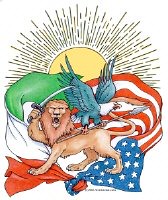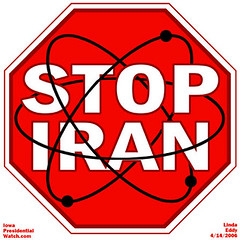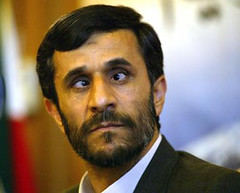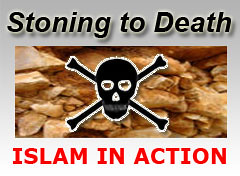Sunday, September 24, 2006
Defense & Foreign Affairs - September 19th
Volume XXIV, No. 56 Tuesday, September 19, 2006
Zawahiri Warns in New Type of Message of Imminent Attacks on the West
Strategy: The Art of Victory: Seizing the Strategic Future
Essential Reading: Victory: More Important Than War or Peace ...
Essential Reading: From the Hejaz: Rare Glimpses of Islam and Saudi Arabia
Zawahiri Warns in New Type of Message of Imminent Attacks on the West
Analysis. By Jason Fuchs, GIS UN Correspondent. The September 11, 2006, video tape of al-Qaida commander Ayman al-Zawahiri released by As-Sahab Productions to commemorate the fifth “anniversary” of the “Ghazvat al-Gha Zavat” (“The Mother of All Raids”) on New York and Washington DC marked a watershed moment in the Islamist-jihadist war on the West.
While many, if not most, Western media outlets dismissed the tape as propaganda, in fact, Zawahiri’s message was the long-promised culmination of a series of taped messages from the global jihadist leadership which directly “paves the way” for new acts of “spectacular” terrorism against the West which are intended to surpass those of September 11, 2001, in lethality and audacity.
While Zawahiri spoke of threats to US interests in the Gulf and to Israel and of the “doomed” efforts of the US military in Afghanistan and Iraq, the message which would be heard most loudly in jihadi circles was the following: “We have repeatedly warned you and offered a truce with you. Now we have all the legal and rational justification to continue to fight you until your power is destroyed or you give in and surrender … The days are pregnant and giving birth to new events.”
Zawahiri was correctly referring to spate of al-Qaida messages released since late 2004 which had seen the jihadist leadership make every effort to gain the widest possible backing and legitimacy in the Islamic world for the upcoming “raids” on the US, which were expected to shock Islamic audiences not only because of their general destructiveness but because significant numbers of Muslim civilians who were expected to be “martyred” as a result of what has been determined to be unavoidable collateral damage.
As a result of this expectation, key al-Qaida leaders, like Osama bin Laden and Zawahiri, had focused their most recent messages secondarily on the promised next series of “spectaculars”, but primarily on going through the perceived protocols articulated in 15 centuries of collective Islamic jurisprudence on the necessary steps that should precede any just military strike. These steps included:
· An offer of truce. Bin Laden’s April 2004 tape had offered Western Europe the opportunity for a truce and his November 2004 “election message” to US citizens provided a similar offer to the US.1 Since that time, bin Laden, as well as other key jihadi ideologues, have made similar offers.
An offer of conversion to Islam. Commanders of the jihadist movement had repeatedly stressed the centrality of conversion to Islam as means for the Judeo-Christian West of avoiding what Zawahiri recently referred to as the “dark” and “pitiable” fate awaiting the American people. The video released by As-Sahab productions on September 2, 2006, featuring Zawahiri and Azzam al-Amriki (US citizen Adam Gadahn) had been entitled “An Invitation to Islam” and was only the most recent manifestation of this trend.
Clear warning. The need to “warn” the US and the West, to make clear to them the result of their “refusal to heel to the path of the shehada (martyrs)”, was paramount.
Zawahiri’s September 11, 2006, message effectively announced that this period was now complete and that the global jihadist movement now retained sufficient legal and theological justification to proceed with the long-planned attacks against the US and the West.
This development was emphasized by an Afghanistan-based al-Qaida commander known as Abu Dawood on September 12, 2006, in an interview at the tomb of Sultan Mehmud Ghaznawi on the outskirts of Kabul with Pakistani journalist and official bin Laden biographer Hamid Mir.
As Dawood explained: “Our cycle of warnings has been completed, now we have fresh edicts from some prominent Muslim scholars to destroy our enemy, this is our defending of jihad; the enemy has entered in our homes and we have the right to enter in their homes, they are killing us, we will kill them.”
Further Dawood specifically warned Muslims in New York and Washington DC that they needed to leave immediately for their own safety, saying: “We cannot stop our attack just because of the American Muslims; they must realize that American forces are killing innocent Muslims in Afghanistan and Iraq; we have the right to respond back, in the same manner, in the enemy's homeland.
The American Muslims are like a human shield for our enemy; they must leave New York and Washington." The use of the term “human shield” was a none too oblique reference that would be readily appreciated in Islamist circles as a nod to what was known as the “shield fatwa debate”.
Detailing the coming strike, Dawood added: “We have a different plan for the next attack. You will see. Americans will hardly find out any Muslim names, after the next attack. Most of our brothers are living in Western countries, with Jewish and Christian names, with passports of Western countries. This time, someone with the name of Mohamed Atta will not attack inside America, it would be some David, Richard or Peter."
In what appeared to be somewhat of a contradiction to this last statement, though, Dawood claimed the “raid” would be led by a commander already inside the US named Adnan el-Shukrijumah who “has smuggled deadly materials inside America from the Mexican border”.
Dawood made clear that this new attack would be “a bigger attack than September 11, 2001”, and that bin Laden would be releasing a new audiotape in the next two weeks.
All this would occur during this coming Ramadan against NATO Forces in Afghanistan in the context of an intensified offensive which was being called the “Badr operation”, according to Dawood.
Thus, the US and the West needed to recognize they were currently engaged in a significantly high threat period, which would not end until either the threat was realized, the “cells” involved were discovered and dismantled, or the sponsoring states, which provided guidance, support, and safe-haven were removed from the strategic playing field.
Footnotes:
1. Following bin Laden’s “election message”, the Islamist website Al-Islah provided an articulate characterization of this development of “truce-offering” as follows: “Some people ask 'what's new in this tape?' [The answer is that] this tape is the second of its kind, after the previous tape of the Sheikh [Osama bin Laden], in which he offered a truce to the Europeans a few months ago, and it is a completion of this move, and it brings together the complementary elements of politics and religion, political savvy and force, the sword and justice. The Sheikh reminds the West in this tape of the great Islamic civilization and pure Islamic religion, and of Islamic justice …” See: www.islahi.net/vboard/showthread.php?t=116432.
2. This referred to the late 13th century debate among Islamic jurists and its 21st century correlative. This seemingly arcane debate over theological jurisprudence had, in fact, played a significant role in jihadist deliberations and, by late 2004, been resolved in bin Laden’s favor, setting the ideological justification for the mass killing of innocent Muslims in forthcoming “spectacular” operations. The original debate had occurred when the Tatar (Mongol) armies destroyed the Abassid caliphate and occupied Baghdad in 1258. In doing so, the Tatars captured large numbers of Muslims, placed them in chains, and then placed them in front of their own forces as human shields during the fighting, creating a major quandary for the Muslim resistance. Was it permissible to attack the Tatars with arrows and catapults and risk killing their brethren in the process, or, should they desist from fighting altogether? The Islamic scholar Ibn Tamiyya issued a fatwa ruling that such attacks were permissible. Bin Laden and his ideological allies argued and received a formal ruling from a small number of influential Saudi jihadi clerics that this provided legal and religious precedent for any Muslim collateral damage in upcoming strikes.
Strategy
The Art of Victory: Seizing the Strategic Future
By Gregory R. Copley, Editor, GIS. Presented to the US Army Command & General Staff College, Leadership Lecture Series, Ft. Belvoir, Virginia: September 15, 2006.
The speech highlighted themes from the new book, The Art of Victory, which is to be released in the US on October 3, 2006.
Turn and take one last look around at the life you have known, at the life we humans have built over the past few thousand years. It is already gone. The granite columns of antiquity remain, ’though they crumble. Humanity, more vast in its numbers, remembers little of its past. This great upheaval we see today is how the epochs change.
Our ego tells us that this era of change is different from all other past human experience; that the future is unchartable and unmanageable. But that is not so. We can shape the future as we have always done, now more than ever before. There are golden times again for us to make.
And yet we are in the eye of the hurricane, an Age of Global Transformation, a pivotal time for humanity. The pace of change is accelerating, not just in science and technology: human numbers are surging, and flooding into urban, mostly coastal, cities and towns, creating a cauldron of friction and potentially revolutionary heat. Climates, too, are changing, and yet we remain fixated on the status quo, and on the promises and fears of the future. Forgotten is the fact that in our past mankind was more aware of the tools of survival with which nature equipped us.
Officers of this Command & General Staff College Course: you are, in the profession of strategy, still young, and have yet to be given great command, ’though your mettle has already been tested in harsh times. You are now being called to even greater service for your country because you have proven to have the essential instincts of courage, decisiveness, loyalty, and intellectual curiosity. These are the noble characteristics of youth, which has the strength to respond quickly and efficiently to the immediate challenges; to be able to obey without question; to uphold the ideals of a civilization handed down from heroes of antiquity.
But, to quote the words from St Paul’s First Letter to the Corinthians:
When I was a child, I spake as a child, I understood as a child, I thought as a child: but when I became a man, I put aside childish things.
For now we see through a glass, darkly …
Thus now you move from the golden horizons of youth into a night of serried shadows. With this Command course, you move from the tactical to the strategic. From the immediate and visible, to the indefinite, the wraith-like, and the invisible. From what, in youth, seems the certain clarity of knowledge to that which, in growing maturity, is the troubling uncertainty and infinite nuance of wisdom. From follower to leader. The marshal’s baton which has merely weighed heavy and useless at the foot of your knapsack must now be the altar which you transport with you. For you are to command the future, if you can but see the broad horizons while retaining the characteristics and vigor which made your command of the immediate — the tactical phalanx — so gratifying to grasp.
Our talk today is of victory, which goes beyond military strategy — although it embraces it — and which transcends any single generation. And if we understand victory, and the path to its achievement, then we will truly contribute to the endurance of our civilization. Once we grasp the meaning of victory we can begin to understand the arts and costs of its achievement.
Victory is infinitely more important than war and peace. Without victory — victory over nature, victory over adversaries, victory over self, victory over ignorance — a society fades to extinction.
Mankind can tolerate the uncertainties and costs of conflict, but without victory there is no lasting peace, or any real peace at all: no prosperity, no control over destiny, no guarantee of survival. Victory at its essence is the survival of the species, and for each us the survival of our own clan and society within the species.
The achievement or loss of victory directs and contours forever the destiny of every society. Victory is not just “winning”. Winning — when viewed down the silent, windswept plains of history — is tactical, a phenomenon which is, by definition, explosive, transitory, and ephemeral. Victory is slow-burning, overarching and transcendent. Victory requires, however, that goals be won or achieved on an ongoing basis. It is neither a permanent nor secure phenomenon.
Society too often mistakes the process of conquest for victory itself, but victory is the sustained delivery of a complex pattern of successes. To be victorious, then, implies the command of an epoch and the fundamental alteration of history. While a single success or defeat may affect history, victory — whether eventually undone or not — marks the path of a society or of mankind.
And yet we take our continued survival for granted, although history tells us that no species is immune from obliteration; no culture, language, ethnic community, nation, or belief system is guaranteed its survival.
We fail to learn from history. We know that the Neanderthals are no more. We know that the languages and beliefs of ancient Egypt are gone beneath the sands, interpreted — as the writings of the Sumerian scribes and poets of ramparted Uruk — from fragmentary scripts, weathered into stone. Most of the ancient languages of my native Australia have flown on the wind, and the last blood of their tribes who spoke them long soaked into the red soil.
We know that there are other peoples, cultures, beliefs, languages, genetic lines: all lost without trace. We do not know how many. They are as though they never existed. Still we persist in the belief in the inevitable linear progression and dominance of our own cultures, tribes, religions, and languages, without doing anything to ensure the survival of our society.
So the survival and dominance of a society through history is its principal victory. As with the chance triumph of Duke William of Normandy on Senlac Hill — the Battle of Hastings — on October 13, 1066, the fate of civilizations turns on unexpected things. Hastings brought us the birth of Anglosphere civilization, which today is the heart of Western or modern civilization. The languages we speak, the generations which may — or, in defeat, may not — follow our family line, the welfare we enjoy: all hang upon pivotal events but must be confirmed and compounded by the consciously-defined processes of history.
So much of the destiny of humanity hangs on what we do every day. The least we can do is to understand what led us here, what ensures our societal future, and how we can ensure that this future — if it indeed is to exist — is in the image we wish it to be.
In my new book, The Art of Victory, I identified 28 maxims to achieve and sustain victory, but there are more. Each maxim on its own merits a book-length discussion, but just let me go into one of the maxims at this point.
In Maxim Four in The Art of Victory, I said: “War is the most common and successful catalyst through which victory is commenced, but once victory is secured, warfare should be the preferred option only when considered against lesser forces.” We cannot forget that it was the Continental Army of the United States which, together with the US Navy and Marine Corps, which essentially initiated the victory of the United States within what was to become the overarching victory of the West. And the US Armed Forces have sustained and defended that victory.
Meanwhile, in 1917, the Red Army was used as an instrument to reinvigorate or initiate what was intended to be a great Russian victory, but in fact the Red Army — or preoccupation with militarism — proved, over 70 years, to be what caused the Sovietized Russian empire to fail. Russia’s drive toward victory was only resumed, in 1991, after the military was essentially put into a more balanced place in the Russian equation.
Maintaining an understanding of these maxims makes the crafting of national and military strategies more contextual and long-term, and expands the field of operations open to a leader. But, as I attempted to show in the book, these tenets apply equally to the command of life at an individual level, as well as within families, or other societies, such as corporations.
In all of this we need to understand how our past relates to our future.
We know that global warming threatens coastal environments and island communities around the world and the viability of life in regions like the arid lands of China’s Xinjiang Province or in Africa’s Sahel. But we cannot know how aware the people of the lower Indus River Valley were that their world was changing as the last Ice Age drew to an end around 10000 BCE. By 8000 BCE, the major cities of the lower Indus Valley were beneath the sea.
Higher up the Indus Valley, a number of major population centers continued to thrive for several thousand years after the last Ice Age. But it was only at the dawn of the 21st Century that the secrets of the cities which had lain hidden for ten millennia on the bed of the Arabian Sea, began to be discovered and are now being interpreted.
The changes faced by the inhabitants of those cities were gradual. The waters lapped incessantly higher over the years. Societies had time to adjust, and drift away to higher ground in what was a period of global warming — such as we appear to be facing now — which transformed the entire environment and all societies. That era, which does not appear in our history books, has direct parallels with today.
Society has constantly transformed, in many ways no more so than with the explosion of literacy following the development of moveable type and printing in 1450. The portability of knowledge caused by this development created new wealth and power. Those societies with widespread literacy and easily-reproduced languages became prosperous and dominant.
All this is our heritage. Our egos tell us that great upheavals are in the past, and we do not need to learn them again. We are different. The future is different. We have tamed change. Or so we believe. But life changes constantly, and we still have not absorbed many of the changes which occurred even during the 20th Century.
After World War II, in the triumphant nations of the Allied West, a “baby boom” created a population bubble in the rich, industrialized societies. This demographic trend skewed and paralyzed the economic and political thinking of our present generation. This moving demographic bloc of “baby boomers”, who are now approaching retirement, will also pass.
Yet few are thinking about the economic consequences beyond this blip. And what if once again totally new reproductive patterns transform the shape of societies? Certainly, China’s one-child policy has already dramatically skewed the gender balance in the world’s most populous nation, with as-yet unknown — but significant — consequences.
The tectonic shifts in history — the discovery of agriculture, the end of the Ice Age, and so on — affected everything from how wars were fought to who came to power, to how societies became prosperous.
Those societies and individuals which succeed do so by recognizing familiar paths through what appears to be an alien landscape of change. The laws of nature have not changed; we have gradually, throughout human development, discovered more and more of what nature has always held in store for us. But we have also forgotten some of the tools with which we were equipped to cope with change.
We are, in fact, better prepared to face the strange new gifts of science and the chaos of mass human concentrations than were the humans who faced the onset of the last Ice Age. And yet their survival forms the very basis of the victory we share today.
The Context of Change
Strategic reality changes as the contextual environment changes. And we are now coming to a confluence of various strands of profound change. We are on the brink of a global shift of humanity which has aspects in common with the end of the last Ice Age, an era which brought the birth of agriculture and the consequent rise of towns and cities.
Some shifts are decided by nature; some by human action. We are now
engaged in a shift which is the result of the works of both nature and man.
Climate and Population
The new global shift includes climatic and environmental change: new patterns of weather, rising sea levels, transformed ocean currents (further compounding the altered weather patterns), the creation of new areas of terrestrial aridity (and revived fertility and productivity in others), and so on. The shift will affect agricultural and habitat viability, with consequent ramifications for political stability in many countries. This process has already begun, and the results are evident within our generation. The timescales of these changes are accelerating.
The new global transformation — the abyss as well as the sunlit upland into which we now stare — includes dramatic and epochal changes in population patterns: the first substantive reorientation of societies since the Middle Ages (which led to the age of colonial migration which essentially created our present global geopolitical shape).
The new age of transformation — the result of the impact of technologies of transportation, computing and mass communications, along with rising but unevenly distributed wealth — has caused a fluid and natural movement of large masses of people from low-opportunity areas to high-opportunity areas. This all changes the nature of sovereignty, the rôle of government, and the functioning of human mechanisms of choice (such as democracy).
At the same time, we are witnessing the first major and progressive population declines in Europe and Africa for hundreds of years, the result of demographic ageing and birth-rate patterns on the one hand, and disease and economic challenges on the other.
But it is also clear from history that globalization will likely lead to even greater sweeping disease pandemics with profound strategic consequences. Quite apart from the impact on demographics, which can distort economic models, disease can strike at the heart of victory. Napoleon Bonaparte would have created a Continental trading system excluding Britain if his 1812 invasion of Russia had succeeded. The impact on history would have been profound, and French could have been the lingua franca of the world today instead of English.
What defeated Napoleon, however, was not only the onset of an extreme Winter in his war against Russia but relapsing fevers transmitted by body lice among his troops. And while the health of leaders, armies, and societies have always been key determinants in history, today, however, perhaps the most challenging — and overlooked — issue facing societies is the question of population.
Not only has the growth of population numbers become an issue of profound importance when considering infrastructure and human needs, globalization has ensured that the phenomenon of population movement and loyalty has, for the first time, become something which must be considered in an entirely new light. “Population strategies” will become the major challenge for governments in the 21st Century.
The Creation of Militant Societies
Change, chaos, and anomie — of which terrorism and alienation within society are but symptomatic parts — will lead rapidly during the coming decade or two to a reactive period of increasing militarization and militancy on a near-universal basis. Where this militant reaction does not occur, the civilizations will perish or erode still further. And the companion of the militarization of society will be increasing “political correctness”. This is a normal coping mechanism of society to assert control over change; to re-assert balance.
The Militarization of Space … and China is in the Lead
The question of the militarization of space is no longer open. Space is, and will increasingly be, militarized. In some very key respects, China has seized the initiative in this arena. Not all of the new space activity will be offensive in nature: apart from contributions to science, space holds the key to neutralizing the viability of offensive strategic ballistic missiles and their nuclear or other strategic payloads.
Dr Stefan Possony, the great strategist, and Ronald Reagan — even before he became US President in 1981 — saw the prospects of such a system, the Strategic Defense Initiative (SDI), which would have been controlled by a consortium of all the major powers, and which would have effectively neutralized the capabilities of strategic ballistic missiles. Few people saw far enough into the future to realize that this system could have brought benefits to all of humanity by making nuclear war less feasible.
But even if we were merely to extend our present capabilities in a linear fashion, terrestrially-based anti-ballistic-missile systems have already reduced the chance of success of North Korean and Iranian ballistic missiles. The greatest potency which lingers for those nuclear weapons held by “rogue states” lies in their psychological impact. Our collective minds are held captive by icons of the past. Science has already moved on, even if many scientists, politicians, and journalists have not.
Transformed Energy, Food, and Water Production
The emerging new technologies will transform food production and fuel efficiencies and, indeed, the very question as to what constitutes fuel. New, safe nuclear energy technologies — which do not pose the same risks as current approaches in terms of waste material or the ability to produce weapons-grade by-products — are on the brink of viability. These will further transform and revitalize human abilities to harness power for industry and for the desalination and movement of clean water, as well as reducing emissions from fossil fuels.
In the late 20th Century, we were contemplating the finite life of energy resources; now we need not. We were contemplating the finite availability of safe drinking and agricultural water, and of food; now we need not.
The Age of Biology is also now full upon us, and once again the farmers will provide renewable fuels for motive power: not hay for horses, this time, but cornstalks, sugarcane, and other agricultural growth into ethanol. Agricultural powers once again will control their own destinies, free from hostage dependency on imported oil.
This comes just in time for the United States, for example, which is now in the last great fight for domination of the fossil fuel marketplace. The US is gradually losing its dominance over that arena, but no matter: even that trend toward the loss of dominance over world oil resources impels the US to ensure the smooth transition to an age dominated not by fossil fuels, but by biofuels and other energies.
But the energy business — possibly the biggest single economic factor in the world today — is like a supertanker; slow to change course. And it never will change course until it sights a reef and the captain gives the order.
The reef is already in sight.
Productive Societies Surrendering to Unproductive Societies?
We know that science and technology offer us the options to take control of our destinies; to avoid, for example, the entanglements which the pursuit of oil has brought. But have we the strength to grasp our destiny in our own hands?
Or is it possible that we could succumb, through loss of will, to a new dark age before we can actually bring these stunning scientific breakthroughs into use? It is up to us whether we choose to be part of the re-birth of a society or part of the slow and geriatric failing and death of one.
Today, the productive nations of the world (the ones which produce and export food surpluses, technologically value-added goods, and services) may squabble among themselves, but their challenge comes almost solely from societies in which the people produce nothing of benefit to their fellow humans. And yet these unproductive societies are using the cheaply-acquired technologies of the productive societies against them.
Think of these challengers to the industrial societies: almost all of them produce nothing of a value-added nature. Some of them may sell oil, or coca leaf, or opium and cocaine, but this is an accident of geography, not a feat of scientific or technological progress. Yet today, all of the efforts by the industrial world are focused on addressing the demands of people who choose not to cherish education and productivity, the tools of survival and prosperity.
In less than a century, the oil-producing states of the Middle East will have nothing of great importance to sell unless they become diversified economies. Oil, by then, will be a minor fuel. We will look back on them as we did, with bemusement, on the salt sellers of old, or the dealers in tulip bulbs in 17th Century Holland. To our detriment, we still focus our attention on the price of oil. To their detriment, the oil-producing states of the Middle East fail to move their societies to literacy, science, and production.
An Age of Savage Wars and Global Criminals
Few people today could name even 10 percent of the countries which existed only, say, 300 years ago.
Italy did not then exist as a sovereign state; neither did the United States, nor Germany, Italy, or Australia. And more countries will appear or disappear in the next few decades in a process which in The Art of Victory I’m calling cratogenesis and cratocide: the birth and murder of nations.
The wars of secession, and the re-shaping of boundaries — largely suppressed by the Cold War — begin anew. The wars to break up Yugoslavia are still unfinalized. And in many of the new wars we will see savagery abound as groups “re-discover” old identities, and seek to capitalize on the permissive climate of change and chaos.
From this turmoil we already see the rise of new global criminal movements benefiting from the globalization of technologies and societies. The international banking constraints imposed to restrict terrorists have not hampered the new, more vicious criminal movements. In all of these, the Albanian criminals have displaced the old Sicilians.
If the 20th Century was the criminal age of the Sicilian mafia, then the 21st Century is the age of the Albanian mafia. Even the Russian mafia, let loose after the collapse of communism, is no match for the Albanian criminal industry, which is now operating across Europe and into the Americas, closely tied to the Islamist jihadists. In many respects, the “al-Qaida” phenomenon owes its success to the financial links with the Albanian mafia, just as the Albanian criminals owe their success to the logistics and networks of al-Qaida.
The chaos of changing borders is fertile ground for criminality. In the coming decades there will be more and more “no go” areas in the world. And this is partly the reason why some societies will react with greater militarization and rigidity. In many respects, the terror has just begun. Emerging criminal states, such as the Kosovo Albanian “state” and even, potentially, Venezuela, could profoundly change our sense of security. We will all feel the reverberations over the coming decade.
But it would be simplistic to say that we are in a “Clash of Civilizations”.
Rather we are seeing new civilizations defined and older ones re-defined. Globalization is changing how ethnic and communal nations interact. But the visible, iconic lifestyles which divide us will continue to be the essence of conflict.
Still, within the competition between societies, the underlying thread that mankind is competing for survival with the rest of nature will come again to the fore. In the “peace” and prosperity which followed the titanic confrontations of the 20th Century, the smug, safe, secure modern states embarked upon the divisive social policy of “multi-culturalism”, which created, essentially, isolated and competitive sub-states of communities within states.
Why should we be surprised, then, when national unity — already pressured by globalization — fails in modern Western societies?
A Context of Victory
In the end, we can see that the world is divided into two basic camps: one which believes it must take responsibility for defining its future; and one which clings to the hope that someone, or something, else will take care of its safety and welfare. Most of us have a foot in both camps, but lean more one way than the other.
The first group retains a more primal comprehension of species survival; the second wants no sacrifice in the standard of living and wealth which our forebears created, heedless of the cost to the future.
Even so, many of the things which impact us are beyond our control: the last Ice Age and the effects of its remission; the current exponential growth in human population numbers; and many aspects of the current global warming pattern akin to the end of the last Ice Age. How we react to things not of our making is the mark of whether or not we will survive and prosper. Those who wait for someone else — government or God — to resolve the problems will be in for an unhappy time.
Nature — God, if you prefer — has already given us the tools to survive against the threats of man and the environment. We just need to use them.
Essential Reading
Victory: More Important Than War or Peace ...
The Art of Victory: Strategies for Personal Success and Global Survival in a Changing World. By Gregory R. Copley. New York, 2006: Threshold Editions, imprint of Simon & Schuster. ISBN-13: 978-1-4165-2470-0, ISBN-10: 1-4165-2470-3.328pp, indexed, bibl. Hardcover, $25. The book will be released in North American bookstores on October 3, 2006.
See www.artofvictory.com.
Victory, the survival of a society with undisputed dominion over its languages, customs, sovereignty, and beliefs, is something the West has long taken for granted. And yet it is a phenomenon which requires assiduous striving and planning. The West, in many respects, has ceased such striving and is spending the fruits of the victory built over more than a thousand years, based on the philosophical, intellectual, and societal underpinnings reaching back into Zoroastrian Persian culture, Greek and Roman civilization, and Viking and Celtic societies.
What lessons can leaders draw from the history of successful and failed civilizations and societies? This is the key to Gregory Copley’s timeless new opus, The Art of Victory: Strategies for Personal Success and Global Survival in a Changing World. The author distills the lessons into 28 major maxims which provide context and a basis for grand strategy, and, under that, political and military strategy.
That the book has been issued by one of the West’s major publishing houses speaks for its general importance, and probably accounts for the tagline of the book, “Strategies for Personal Success and Global Survival in a Changing World”. But make no mistake: this is a book for professionals in national management and national security.
The Art of Victory was based on a much larger, extensively documented study for Western intelligence and political leaders, but the public edition which has now gone on sale is eminently readable and understandable. It is also, in essence, the “marshal’s baton” to be carried in the knapsack of future leaders.
The Art of Victory is the first book ever published which deals specifically with psychological strategy, the parent art of psychological warfare, and the facilitating mechanism of grand strategy. For that matter, The Art of Victory is a true handbook on how grand strategy functions.
But this sophisticated yet flowing book also places the timeless maxims into a context of current and anticipated global events, showing the relationships between globalization, climate change, and science and technology, as well as highlighting how the destruction of hierarchies which occurred following the end of the Cold War enables the development of new strategic frameworks.
Copley introduces us to two new words and concepts: cratocide and cratogenesis, the murder and birth of nations. In discussing the transformation of Westphalian sovereignty with colleague Dr Marios Evriviades — a Cypriot of Greek background — they settled on descriptors based on ancient Greek, but appropriate to the emerging age of changing state boundaries and the appearance and disappearance of states.
Gregory Copley, Editor-in-Chief of the Defense & Foreign Affairs series of publications is well-known for introducing the world to analysis from a grand strategy standpoint, something he says he learned from a quarter-century of work with the late Dr Stefan T. Possony, to whom The Art of Victory is dedicated. In his acknowledgments, Copley said that Possony was known as “the greatest strategic philosopher of the 20th Century”, but “his work was even wider-reaching than that”.
Devotees of Possony’s classical studies on strategy will find an echo of that great master in Victory, but Copley has taken the study even further.
The book has 30 main chapters:
Prologue: The Emerging Global Revolution
1 Defining Victory
2 Embarking on the Path to Victory
3 Defining a Grand Strategy for Victory
4 The Rôle of War in Victory
5 Mastering Self, Mastering Fate
6 God and Victory
7 The Pre-Requisites of Victory
8 Abstraction, Complexity, and Victory
9 Positioning Perceptions for Victory
10 Identity as the Core of Victory
11 The Failure, and Promise, of Terrorism
12 The Care and Feeding of Enemies
13 When Destruction is the Aim, Victory is Not
14 Making Victory Endure Through “Legitimacy”
15 The True Leader
16 The Passion of Leadership
17 Perceptions of Leadership
18 The Great Symbiosis of Leader and Led
19 Loyalty and Survival
20 The Never-Ending Challenge
21 Welcome to an Interregnum of Cratocide and Cratogenesis
22 Victory’s Unique DNA
23 The Gift Which Cannot be Given
24 The Gift to Oneself
25 Strength and Courage: the Hallmarks of Victory
26 My Country, Right or Wrong ...
27 The Sum of All Strengths
28 The Teamwork of Leader and Society
Epilogue: The Art of Victory in the Age of Opportunity
Copley notes: “Victory ... is eternal; its achievement or loss directs and contours forever the destiny of every society. Victory is not just “winning”. Winning — when viewed down the silent, windswept plains of history — is tactical, a phenomenon which is, by definition, explosive, transitory, and ephemeral.
Victory is slow-burning, overarching and transcendent. Victory requires, however, that goals be won or achieved on an ongoing basis. It is neither a permanent nor secure phenomenon. Society too often mistakes the process of conquest for victory itself, which is the sustained delivery of a complex pattern of successes. To be victorious, then, implies the command of an epoch and the fundamental alteration of history, personal or societal. While a single success or defeat may affect history, victory — whether eventually undone or not — marks the path of … mankind.”
This is a rare book which will be read with relevance for decades into the future, and should form a permanent part of all strategic libraries. It is the logical next step after Sun-tzu, Machiavelli, and von Clausewitz. — Pamela von Gruber
Essential Reading
From the Hejaz: Rare Glimpses of Islam and Saudi Arabia
Twilight in the Kingdom: Understanding the Saudis. By Mark A. Caudill. Westport, Connecticut, 2006: Praeger Security International. ISBN: 0-275-99252-7. 151pp, photographs; map, glossary, index. Hardcover, $44.95 (UK Sterling Price: £25.99).
Saudi Arabia and Islam figure prominently in the strategic consciousness of policymakers in the early 21st Century, but the religion — and particularly the sects of it — is little understood outside the faith, and there is scarce any balance in assessments of where the Kingdom of Saudi Arabia is going. To be fair, Arabia and Islam discourage deep research by outsiders, and even insiders, so unfair characterizations of the land, and the religion which centers on it, are bound to occur.
US diplomat and Muslim Mark A. Caudill, however, went to great lengths in Twilight in the Kingdom: Understanding the Saudis to provide a comprehensive and balanced view of the Kingdom of Saudi Arabia, and the Muslim rites which guide the faithful to perform religious oblations at Mecca. In so doing, he became one of a select band of Westerners who have done great work in penetrating the veil which has shrouded Arabia for centuries, writers such as St. John Philby, Sir Richard Burton and the like.
Caudill, who converted to Islam before being assigned to the US Consulate General in Jeddah, the capital of the Hejaz, served in the Kingdom as a diplomat from 1999 until 2002, a fateful span considering the September 2001 terrorist attacks on the United States which featured predominantly Saudi citizens. But as a Muslim — albeit as a US diplomat — Caudill was able to participate freely in the hajj, and he describes in detail the three types of hajj: the tamattu’, qiraan, and ifraad.
His writings on the process of the hajj, and the historical development of it, is profoundly interesting and important, because he gets into the human and bureaucratic aspects as much as the religious symbolism. But he also gets into the society as a whole, and particularly — mainly — Hejazi society.
The Hejaz, region of the two most important cities in Islam, Mecca and Medina, only came under the domination of the Wahhabist House of Saud in 1924-25. Little wonder, then, that this significant region of Arabia, the source of its great trade — and pilgrimage traffic to holy shrines, even in pre-Islamic times — was looked upon warily by the bedouin Nejdi Al Sauds, and vice versa.
Caudill’s book is full of insights, and it is difficult to capture the breadth and detail of his work — essentially a compilation of reports written during his tenure in country, with later additions — other than to say that it would be foolhardy for an analyst to attempt to assess modern Saudi Arabia without it.
He does not proselytize in favor of either Islam of Saudi Arabia, instead reporting analytically, but with the benefit of intimate contacts within the society. His extensive glossary of terms at the end of the book alone will ensure that it is seen as a constant reference source for writers on the Middle East.
Caudill leaves reader to draw their own conclusions, and in many instances the conclusions which must be drawn about the problems faced by the Saudi Kingdom in Arabia are less than optimistic. Nonetheless, Caudill performed an outstanding service for US-Saudi relation by expanding the understanding which each state can have of the other, but particularly by putting flesh on the bones of Saudi Arabia’s image in the West.
His book is also of great service in delving into the great conflicts between the Q’uran’s own words and the sunna and hadith which — Mohammed’s practices and his words and deeds as recounted by associates — and how this affects the modern Muslim society, and particularly the modern Wahhabist. —
Subscribe to:
Post Comments (Atom)














No comments:
Post a Comment